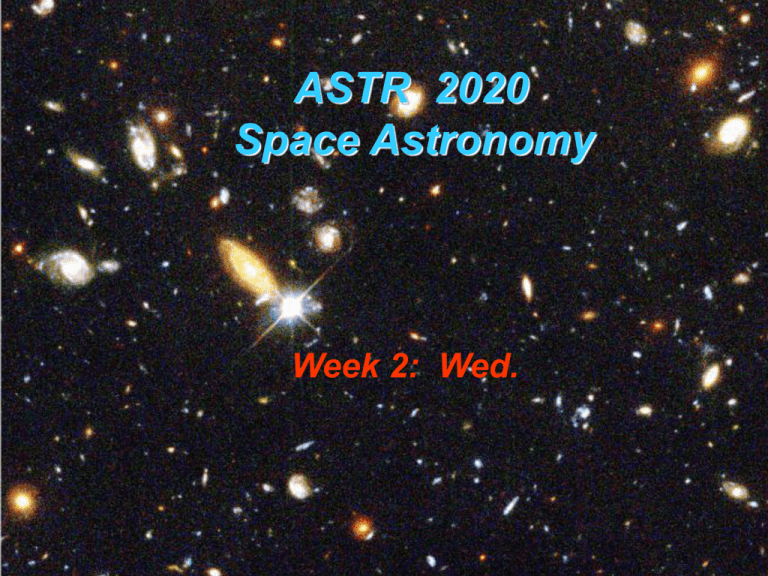ASTR 2020 Space Astronomy Week 2: Wed.
advertisement

ASTR 2020 Space Astronomy Week 2: Wed. The Winter sky …. Infrared view of winter sky (10 - 120 mm) Star A large, glowing ball of gas that generates heat and light through nuclear fusion Visual wavelength UV & X-ray wavelengths Properties of Thermal Radiation 1. Hotter objects emit more light at all frequencies per unit area. 2. Hotter objects emit photons with a higher average energy. 1 nm “nano meter”: = 10-9 m = 10-7 cm = 10 Angstroms = 10-3 mm Thermal (Black-body) radiation: [peak wavelength] = 0.3 cm / [Absolute Temperature (Ko )] Wien Rayleigh-Jeans ASTR 2020 Space Astronomy Week 2: Friday Electromagnetic (EM) Radiation • Light: - lwavelength, n = frequency ln = c = 2.998 x 1010 cm/s (in vacuum) E = h n Photon energy (erg) 1 erg sec-1 = 10-7 Watt h = 6.626 x 10-27 (c.g.s) 1 eV = 1.602 x 10-12 erg - p = E / c = h / l Photon momentum l = h / p = h / mv Wavelength of a particle • Black-body Planck Function: Bn(T) The Planck Function: Black-body radiation (erg s-1 cm-2 Hz-1 2 p sr-1) Wien: B(n,T) = (2 phn3 / c2) e-hn/kT Rayleigh-Jeans: B(n,T) = 2 p kT / l2 Review of Some Basics • Angular resolution: q = 1.22 l / D radians 206,265” in a radian • Flux F = L / 4 p d2 • Flux density (per Hz) 1 Jansky = 10-26 (W m-2 Hz-1) = 10-23 (erg s-1 cm-2 Hz-1) Constants: c = 3 x 1010 cm/sec, k = 1.38 x 10-16 h = 6.626 x 10-27 mH ~ mproton = 1.67 x 10-24 grams me = 0.91 x 10-27 grams eV = 1.602 x 10-12 erg Luminosity of Sun = 4 x 1033 erg/sec Mass of the Sun = 2 x 1033 grams Luminosity & Flux - Luminosity: Energy given off each second energy is measures in ergs luminosity is an erg/second 1 Watt = 107 erg /sec - Flux: flow or energy though a unit area. [erg sec-1 cm-2] Example: Flux of energy from the Sun: Sun’s luminosity = 4 x 1033 erg sec-1 Sun’s mass = 2 x 1033 grams) Distance between Earth & Sun D = 1.5 x 1013 cm = 1 Astronomical Unit = 1 A.U. Flux = L / 4 p D2 = 4 x 1033 / (4 x 3.14 x 1.5x1013*2) = 1.4 x 106 erg s-1 cm-2 = 1.4 x 1010 erg s-1 m-2 = 1400 Watts m-2 = 1.4 kW m-2 The Doppler Effect Motion changes wavelength & frequency: Let: fobserved - frest = f = “change in frequency” lobservedlrest = l = “change in wavelength” f/f = ll V / c = “velocity in units of speed of light” Fractional change in frequency & wavelength = [velocity along line-of-sight] / [speed of light] Spectra of Galaxies: (Calcium H+K lines) Spectrum of Comparison lamp (He + Ne + Ar) Spectrum of galaxy Example: Freflect = ftrans +/- f f = 2 f (V/c) f = 10 GHz = 1010 Hz Police V = 100 km/h = 27.8 m /s = 2.78 x 103 cm/s Radar: c = 3 x 1010 cm/s = 3 x 105 km/s f = 2 f V / c = 2 [1010 Hz][2.78x103 cm/s] / [3x1010 cm/s] = [2 x 2.78 / 3] [10 10+3-10] = [5.56 / 3] x 103 Hz = 1.85 x 103 Hz = 1,850 Hz Picky Clouds A cloud of particles absorbs all of one type of light and transmits all others. If there are an equal number of photons of all types of light hitting the cloud, which type of cloud would heat up the fastest. a) b) c) d) e) Absorbs Radio Absorbs X-Ray Absorbs Far IR Absorbs Near UV Absorbs Visible Picky Clouds A cloud of particles absorbs all of one type of light and transmits all others. If there are an equal number of photons of all types of light hitting the cloud, which type of cloud would heat up the fastest. a) b) c) d) e) Absorbs Radio Absorbs X-Ray Absorbs Far IR Absorbs Near UV Absorbs Visible X-Ray photons have the shortest wavelength/highest frequency, therefore the most energy per photon LASERS!!! You have a 5mW laser, which color of laser will have the highest photon count per second? a) Blue b) Yellow c) Red d) Green e) Cyan LASERS!!! You have a 5mW laser, which color of laser will have the highest photon count per second? a) Blue b) Yellow c) Red d) Green e) Cyan Red photons have the highest wavelength, therefore the lowest frequency, and therefore the lowest energy per photon Freflect = f trans + / - f f trans f = 1850 Hz frequency of `beat wave’ (envelope) Mixers signal in w1 local oscillator w2 signal out w1+w2 and w1w2 LO A mixer takes two inputs: the signal and a local oscillator (LO). The mixer outputs the sum and difference frequencies. In radio astronomy, we usually filter out the high frequency (sum) component. Single sideband mixer: Local oscillator Down-converted signal f = 10 GHz F + f = 10 GHz + 1850 Hz 1850 Hz f = fIF Frequency Band-pass of amplifier: Intermediate frequency = IF Observing in the Radio i.e. The NRAO GBT (D ~ 100 m) at 21cm = 1.420 GHz l 21cm q 7. 2' D 10000cm at 0.3 cm = 100 GHz l 0.3cm q 0.10' 6.2' ' D 10000cm Planetary Radar imaging: Doppler shift + time delay = 2D map Redshift Radar Pulse Blueshift Early echo Late echo UV Venus Radar Radar signal Mixers LO mixed signal 0 Hz original signal frequency Mixers signal The negative frequencies in the difference appear the same as a positive frequency. LO mixed signal 0 Hz original signal frequency To avoid this, we can use “Single Sideband Mixers” (SSBs) which eliminate the negative frequency components. Amplification Amplification is in units of deciBells (dB) logarithmic scale 3 dB = x2 5 dB = x3 10 dB = x10 20 dB = x100 30 dB = x1000 V1 dB 10 log 10 ( ) V2


